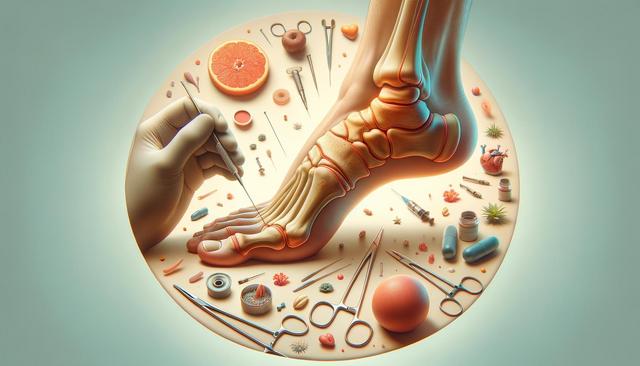What Is Bunion Surgery?
Bunion surgery, also referred to as a bunionectomy, is a medical procedure aimed at correcting a deformity in the joint at the base of the big toe. This deformity, known as a bunion, occurs when the big toe pushes against the next toe, forcing the joint to stick out. Over time, this can cause significant pain, inflammation, and difficulty walking. So, what is bunion surgery exactly? It involves realigning the bones, tendons, and ligaments in the foot to restore normal anatomy and relieve discomfort. The type of surgery performed often depends on the severity of the bunion and the specific needs of the patient.
There are several methods used in bunion surgery, including:
- Osteotomy – cutting and realigning the bone
- Exostectomy – removing part of the bunion
- Arthrodesis – fusing the joint
The goal of the surgery is not just cosmetic. It is primarily performed to reduce pain and improve foot function. Patients considering this option should consult with a healthcare professional to determine the most suitable approach for their condition.
How Does Bunion Surgery Work?
Understanding how bunion surgery works can help patients set realistic expectations and reduce anxiety about the procedure. Generally, the surgery is performed under local or general anesthesia and takes about one to two hours, depending on the complexity of the case. During the operation, the surgeon makes an incision near the affected joint to access the bones and tissues. Based on the specific surgical technique, the bunion is either removed, or the bones are cut and repositioned.
Some procedures may also involve the use of screws, pins, or plates to hold the bones in place as they heal. These materials are often left inside the foot permanently unless they cause complications later. Post-surgery, the incision is closed with stitches, and the foot is bandaged to promote healing and reduce swelling.
How does bunion surgery work best? It often depends on following detailed post-operative care instructions, minimizing weight-bearing activities, and attending follow-up appointments to ensure proper healing. Each individual’s experience may vary, but a clear understanding of the procedure provides a solid foundation for recovery.
Recovery Timeline After Bunion Surgery
The recovery timeline after bunion surgery can vary widely depending on the type of procedure performed and the patient’s overall health. Typically, patients can expect a multi-phase recovery process that spans several weeks to months. In the first few days, it is essential to rest, elevate the foot, and manage pain with prescribed medications.
Here is a general overview of the recovery stages:
- Week 1–2: Focus on rest, limited mobility, and keeping swelling down
- Week 3–6: Gradual increase in weight-bearing activities with protective footwear
- Week 6–12: Transition to regular shoes and physical therapy
- Month 3+: Return to normal activities, though full recovery may take 6–12 months
Understanding the recovery timeline after bunion surgery helps patients plan ahead, especially if they need to take time off work or arrange for help at home. Compliance with post-surgical care, including avoiding strenuous activities and attending follow-up appointments, is critical to achieving the best outcome. Patience and proper care go a long way in ensuring a smooth and successful recovery.
Cost Of Bunion Surgery
The cost of bunion surgery can depend on several factors, including the type of surgery, the healthcare provider’s fees, and whether the procedure is covered by insurance. On average, the total expense can range from a few thousand to several thousand dollars. This amount typically includes the surgeon’s fee, anesthesia, hospital or surgical center charges, and post-operative care.
Factors that influence the cost of bunion surgery include:
- Geographic location of the medical facility
- Complexity of the surgery required
- Surgeon’s experience and specialization
- Pre- and post-operative care, including physical therapy
Patients should always check with their insurance providers to understand what portion of the cost is covered. Some plans may consider the surgery medically necessary and provide coverage, while others may not. It’s advisable to get a detailed estimate from the medical provider and clarify what out-of-pocket expenses may be expected. Being informed about the cost of bunion surgery helps patients make educated decisions about their treatment options.
Best Shoes After Bunion Surgery
Choosing the right footwear is crucial for a comfortable and effective recovery. The best shoes after bunion surgery are those that provide adequate support, cushioning, and room for the healing foot. During the initial recovery phase, patients are often advised to wear a surgical boot or post-operative shoe that limits movement and protects the surgical site.
As healing progresses, transitioning to appropriate everyday shoes is essential. Here are some features to look for:
- Wide toe box to reduce pressure on the toes
- Soft, flexible materials that accommodate swelling
- Adjustable straps or laces for a customized fit
- Shock-absorbing soles to reduce joint stress
Some patients may benefit from custom orthotics to support proper foot alignment and prevent future issues. Consulting with a podiatrist or orthopedic specialist can help identify the best shoes after bunion surgery based on individual needs. Wearing the right footwear not only supports healing but can also prevent the recurrence of bunions and improve overall foot health.




Leave a Reply